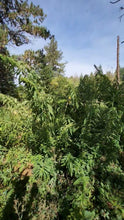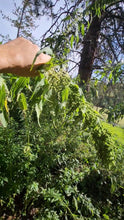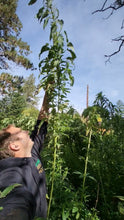'Less Sting' Stinging Nettles
Regular price
$3.75
Sale
Urtica dioica
Origin: Michigan
Improvement status: Cultivated wild material
Seeds per packet: ~200
Germination tested 10/2025: 60%
Life cycle: Perennial
Our friend Ken Asmus, the founder of Oikos Tree Crops, found 'Less Sting' stinging nettles growing at his farm in western Michigan. While it still has the typical amount of stinging hairs on its stems and petioles (leaf stalk), the leaves are almost entirely free from them. Ken has long sold clones of this plant (which, like all stinging nettles, spreads easily and rapidly by underground rhizome), and one of his customers was our new grower Michael Billington of Nourishing Roots Farm in Montana. Michael grew this seed, and we're excited to see if spreading it around widely yields new clones that might be even less stinging.
But while nettles are notorious for their eponymous sting, those of us who love this plant can easily look past this unfortunate trait. Its capacity to cause pain is just one small facet to this otherwise fascinating and fantastic being. A veritable drugstore, department store, and supermarket rolled into one, nettles provide food, fiber, dye, and medicine.
As a natural medicine, stinging nettles have long been recognized as powerful. The same chemicals that cause the stinging sensation can actually reduce pre-existing pain, which is why fresh, raw stinging nettles have long been applied to arthritic and otherwise painful joints. Scientists believe this is due to nettles reducing levels of inflammatory chemicals in the body and disrupting the usual pain signals the body sends itself. According to Mount Sinai Hospital, "stinging nettle has been used for hundreds of years to treat painful muscles and joints, eczema, arthritis, gout, and anemia. Today, many people use it to treat urinary problems during the early stages of an enlarged prostate (called benign prostatic hyperplasia or BPH). It is also used for urinary tract infections, hay fever (allergic rhinitis), or in compresses or creams for treating joint pain, sprains and strains, tendonitis, and insect bites."
The fibers in nettle stalks can actually be spun into a soft and versatile yarn. Before cotton reached Europe, nettle ranked with flax and hemp as a top natural fiber for making clothes, and people still make clothes with it today (the fabric material called "ramie" is made from another species of nettle). The fiber has fire-resistant properties, and it's hollow, which means it's cool in the summer and warm in the winter. It can be compared to linen (from flax), but it's said to be stronger and softer. The leaves make a lovely colorfast dye that ranges from green through grey-green and blue-green to brown, depending on when the leave are harvested (earliest spring leaves yield the greenest dye).
I (Nate) most value stinging nettle as the ultimate wild spring vegetable — right up there with ramps (Allium tricoccum), but more valuable because when you have enough of it you can really treat it like a staple food. Once nettle leaves are exposed to heat, they rapidly wilt and the tiny hairs that cause the stinging sensation lose their potency. My favorite way to use the leaves is in soup (using water, stock, or milk as a base), but they also make a great addition to mashed potatoes or other vegetables, scrambled eggs or omelets, various stir-fries or curries, or as a meaty-tasting filling in vegetable dumplings, empanadas, or pierogies (or any other stuffed food!). To my non-meat-eating taste-buds, nettles taste more like meat than any other plant. I can't really explain why, but I know I'm not the only one who thinks so. Perhaps it has something to do with the fact that nettles contain all of the essential amino acids — like meat and eggs, and precious few other green vegetables.
Nutritionally, it's hard to beat stinging nettles. They contain significant quantities of potassium, protein, magnesium, Vitamin B6, and Vitamin C, along with loads of fiber, calcium, and Vitamin A. The one drawback (besides the sting) is that nettles should not be consumed after the plants begin to flower: at that point calcium carbonate begins to build up in the leaves which can cause damage to the kidneys and/or urinary tract (but, ironically enough, spring nettle infusions are considered by many to be important medicine for kidney and urinary issues). If you find plants in the wild that clearly haven't flowered (the flowers look something like green dreadlocks), even if its late in the summer or fall, you can eat them with confidence. The seeds are edible too, though I don't know many people who eat them, but supposedly they are very high in Omega-3 fatty acids.
Nettle tea is popular around the world, wherever it grows (and while it's native to Eurasia, it now grows throughout the temperate world). In Hawai'i, another plant in the nettle family, mamaki, makes a beloved tea. When I lived in the Netherlands, as a non-caffeine-drinker I quickly learned that stinging nettle ("brandnetel" in Dutch) is among the most popular herbal teas, alongside peppermint and chamomile, available at practically every restaurant, cafe, and coffeeshop in the country. But dried stinging nettle leaves aren't just good for tea: they can continue to be used as a vegetable too, easily rehydrated for soups and other dishes, so it's good to harvest as much as possible during the 2-4 month window before they begin to flower and dry as much as you can.
Stinging nettles grow best along edges. They can often be found where field meets forest, and they often take over disturbed areas. They can thrive in full sun or nearly complete shade. They are cold hardy perennials and definitely will spread if given half a chance. We recommend planting them someplace where it won't be a problem for them to form an impenetrable wall of stinging leaves (like by a fence in a little visited corner of your property, or an ignored patch of land next to a ballfield or park). The best patches of stinging nettles are out-of-the-way enough for you to get your fill each spring and not be bothered by them the rest of the year.






